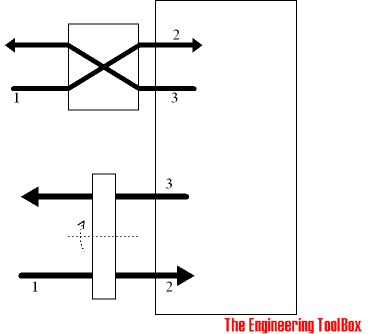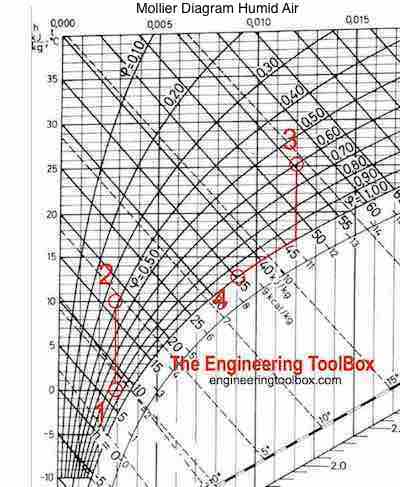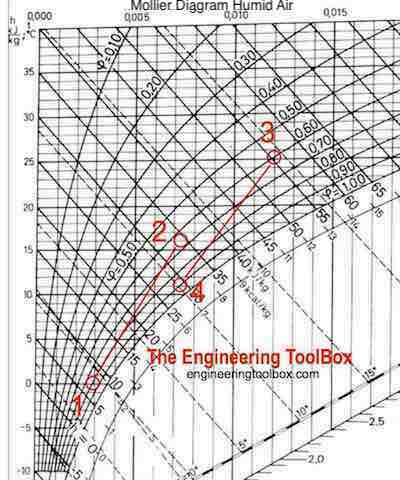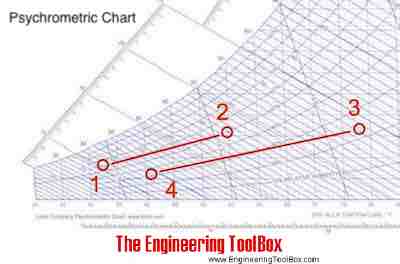Heat Recovery Efficiency
Classification of heat recovery efficiencies - temperature efficiency, moisture efficiency and enthalpy efficiency - online heat exchanger efficiency calculator.
Common Energy Recovery Principles
Heat recovery units used in ventilation and air condition systems are based on some common principles:
- Return air
- Rotating heat exchangers
- Air-Fluid-Air exchangers
- Cross flow exchangers
- Heat pumps
Cross flow and rotating heat exchangers are illustrated below:

Return Air Recovery Units
In a return air recovery unit - used air is mixed into the make-up or supply air. Energy in outlet air is supplied directly into the make-up air. Both sensible and latent (moisture) heat is transferred.
Rotating Heat Exchangers
In a rotating heat exchanger - outlet air heats (or cools) the exchanger when the wheel passes through the outlet air flow. The energy is transferred to the make-up air when the wheel passes through the make-up air.
Both sensible and latent heat may be transferred. Latent heat when moisture in the outlet air condensates on the wheel. More moisture may be transferred using a hygroscopic wheel. For exchangers without hygroscopic wheels most of the condensate is drained out.
Air-Fluid-Air Exchangers
In an air-fluid-air heat recovery unit - heat is transferred in an heat exchanger from the outlet air to a circulating fluid. The fluid is circulated to a heat exchanger in the make-up air where the heat is transferred to the supply air.
Both sensible and latent heat may be transferred. Latent heat when moisture in the outlet air condensates in the heat exchanger. The moisture is not transferred.
Cross Flow Heat Exchangers
In a cross flow heat exchanger - heat is transferred directly from the outlet air to the make-up air through the separating walls in the heat exchanger.
Both sensible and latent heat may be transferred. Latent heat when moisture in the outlet air condensates on the heat exchanger. The moisture is not transferred.
Heat Pumps
A heat pump makes it possible - with some additional energy - to move more outlet air energy to the make-up air than any other system. The energy consumption is approximately 1/3 to 1/5 of the recovered energy.
Both sensible and latent heat may be transferred. Latent heat when moisture in the outlet air condensates on the heat exchanger. Moisture is not transferred.
Heating Process - Recovery without Moisture Transfer
The heating process without moisture transfer with a recovery unit - typical like the cross flow unit in the figure above - can be visualized in a psychrometric Mollier diagram as

Heating Process - Recovery with Moisture Transfer
The heating process with moisture transfer and a recovery unit - typical like the rotating wheel unit in the figure above - can be visualized in a psychrometric Mollier diagram as

The heating process with heat and moisture recovery can alternatively be visualized in a psychrometric chart as

Temperature Transfer Efficiency
The temperature transfer efficiency for an heat recovery unit can be calculated as
μt = (t2 - t1) / (t3 - t1) (1)
where
μt = temperature transfer efficiency
t1 = temperature in outside make-up air before the heat exchanger (oC, oF)
t2 = temperature in outside make-up air after the heat exchanger (oC, oF)
t3 = temperature in outlet air before the heat exchanger (oC, oF)
Moisture Transfer Efficiency
The moisture transfer efficiency for an heat recovery unit can be calculated as
μm = (x2 - x1) / (x3 - x1) (2)
where
μm = moisture transfer efficiency
x1 = moisture outside make-up air before the heat exchanger (kg/kg, grains/lb)
x2 = moisture outside make-up air after the heat exchanger (kg/kg, grains/lb)
x3 = moisture outlet air before the heat exchanger (kg/kg, grains/lb)
Enthalpy Transfer efficiency
The enthalpy transfer efficiency for an heat recovery unit can be calculated as
μe = (h2 - h1) / (h3 - h1) (3)
where
μe = enthalpy transfer efficiency
h1 = enthalpy in outside make-up air before the heat exchanger (kJ/kg, Btu/lb)
h2 = enthalpy in outside make-up air after the heat exchanger (kJ/kg, Btu/lb)
h3 = enthalpy in outlet air before the heat exchanger (kJ/kg, Btu/lb)
Related Mobile Apps from The Engineering ToolBox 
- free apps for offline use on mobile devices.
Heat Exchanger Efficiency Calculator
The calculator below can be used to calculate temperature, moisture or enthalpy efficiency for an heat exchanger - both Imperial and Metric units. The heat (kW) exchanged calulation is valid for metric units.



